26 National Parks That Preserve Native American Heritage & Cultural Sites
Just like many other aspects of U.S. history, the relationship between the national parks and Native Americans is complicated at best.
Several national parks were created on Native American lands during the Indian Wars of the late-19th century, while other sites and monuments protect important landmarks or commemorate events and battles.
As you’ll see in this lengthy blog post, there’s absolutely no shortage of national parks that preserve Native American heritage sites. What occasionally does lack, however, is a nuanced historical narrative in visitor centers, on information boards and in brochures.
Greatest National Parks With Native American Heritage & Cultural Sites

In many cases, a park’s story is told from a white man’s perspective. Whether the focus lies on one of the iconic emigrant trails, such as the Oregon Trail or Mormon Trail, or a frontier U.S. army fort, sometimes the near-absence of the Native American story is striking.
That’s not the case everywhere, though. More and more parks have started to shift their tone and are now including Native American culture in their presentation of the park.
After all, while modern Americans have been around for, give or take, three centuries, the Native American story is many millennia long! They have a lot more to say.
Therefore, I really wanted to dedicate an entire blog post to the many fascinating Native American heritage sites in U.S. national parks.
This post about national parks with Native American heritage sites contains affiliate links. You can read more about our Terms of Use / Disclosure here.
26 National Parks That Preserve Native American Heritage Sites
With all that overwhelming natural splendor, from massive Mount Rainier to the gaping Grand Canyon, from the endless wetlands of the Everglades to the Yellowstone wildlife, it’s easy to forget that America’s National Park System also preserves a wealth of other things and places.
And the literally thousands of Native American heritage sites that are managed by the National Park Service are definitely among them.
Since Native Americans lived all across the USA, I figured it’d be useful to split up these numerous national parks with Native American heritage sites by region. You’ll find them in the following order:
- Southwest Native American heritage sites
- Great Plains Native American heritage sites
- Pacific Northwest and Alaska Native American heritage sites
- Midwest Native American heritage sites
- Southeast Native American heritage sites
You’ll find all kinds of places in this post, from national battlefields and historical parks to national monuments and actual national parks, too.
I will provide a selection of recommended books about Native American-related topics at the end of this post. If you’re interested in learning more, those would be an excellent place to start.
Native American Heritage Sites of the Southwest
Many of the Native American heritage sites in the national parks of the Southwest are Ancestral Puebloan sites.
Thriving from 900 to 1350 AD, this ancient Native American culture covered what is now the Four Corners region, which includes northeastern Arizona, southeastern Utah, southwestern Colorado and northwestern New Mexico.
To the south of the Ancestral Puebloan region were two other major ancient Native American cultures.
The Hohokam Culture spanned much of south(west)ern Arizona, while the Mogollon Culture extended from southwestern New Mexico and southeastern Arizona deep into present-day northern Mexico.
Other cultures in the American Southwest that left behind ruins and other structures are the Salado and Sinagua Cultures. Modern-day Native American tribes in the Southwest include the Hopi, Zuni, Navajo, Pueblo, Yavapai and Apache.
Although these ancient Native American cultures of the American Southwest, a region known as Oasisamerica by anthropologists, had their differences, they are collectively known for their family pit houses, cliff dwellings, great houses, pueblos and/or towers.
Aztec Ruins National Monument, New Mexico
Native American tribe(s): Ancestral Puebloans
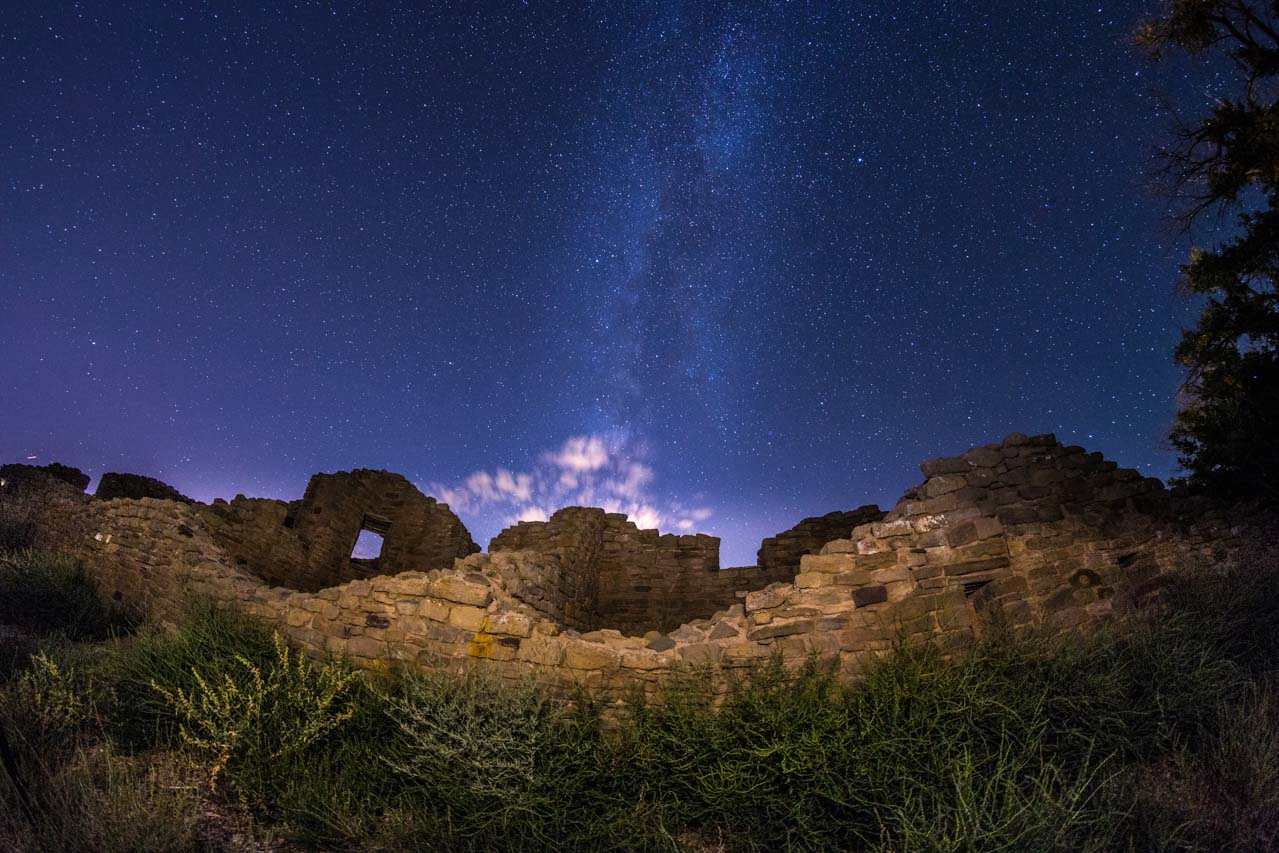
Named “Aztec ruins” by 19th-century American settlers who mistakenly assumed the Aztecs built them, the Native American ruins in this national monument were actually constructed by the Ancestral Puebloans in the 12th and 13th centuries.
The star attraction in Aztec Ruins National Monument is the “Great House”, a magnificent collection of ruins of rooms, houses and other dwellings. In its heyday, this was one of the region’s main political, social and economic centers, second only to Chaco Canyon.
It is part of the Chaco Culture UNESCO World Heritage Site.
Aztec Ruins National Monument website: https://www.nps.gov/azru/index.htm
Chaco Culture National Historical Park, New Mexico
Native American tribe(s): Ancestral Puebloans, Navajo

From about 850 to 1250 AD, Chaco Canyon was the beating heart of the Ancestral Puebloan culture, the home of thousands of people. As the National Park Service says, it was “the center of an ancient world.”
The many pueblos and massive buildings that dot New Mexico’s Chaco Culture National Historical Park are testimonies to engineering and social skills not found anywhere else in the Southwest.
In this park, which is a UNESCO World Heritage Site, you can see the greatest collection of ancient Native American ruins north of Mexico, one of the most significant pre-Columbian areas in the U.S.
Conveniently, it makes for a amazing short detour from iconic Route 66.
Major highlights include Pueblo Bonito, Chetro Ketl, Pueblo del Arroyo, Una Vida, Hungo Pavi and Casa Rinconada, all of which are along the fantastic 9-mile Canyon Loop Drive.
Chaco Culture National Historical Park website: https://www.nps.gov/chcu/index.htm
Bandelier National Monument, New Mexico
Native American tribe(s): Ancestral Puebloans
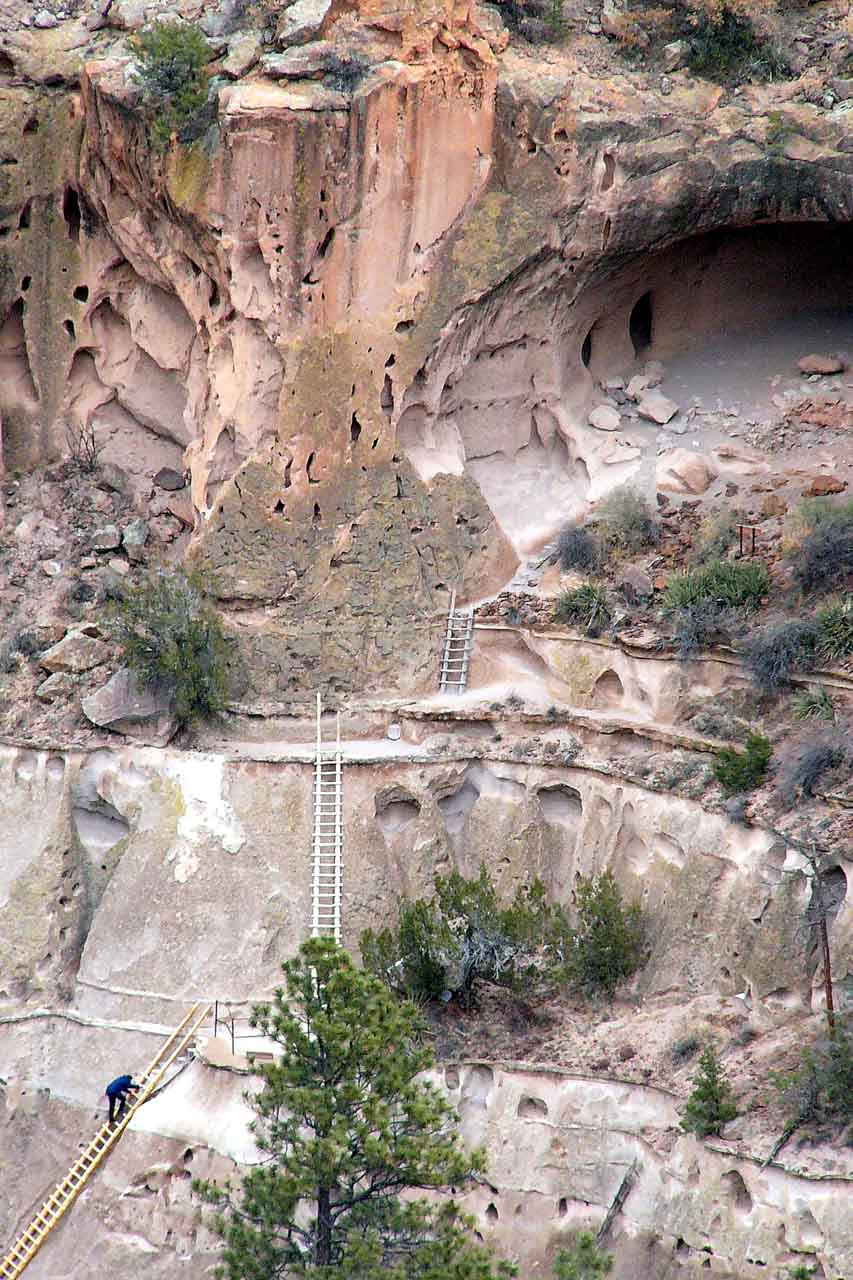
Protecting more than 33,000 acres of canyons and mesas in northern New Mexico, Bandelier National Monument is home to several Native American sites. Those include everything from cliff dwellings and the remains of masonry buildings to petroglyphs.
The monument is named after Aldolphe Bandelier, a Swiss-American anthropologist who researched and advocated for the preservation of these archaeological sites.
Major landmarks are the circular Tyuonyi Pueblo, the Long House, the Big Kiva, and Alcove House, which is reachable via four wooden ladders.
Bandelier National Monument website: https://www.nps.gov/band/index.htm
Canyon de Chelly National Monument, Arizona
Native American tribe(s): Ancestral Puebloans, Navajo

People have lived in Canyon de Chelly uninterruptedly for more than 5,000 years, making it the longest continuously inhabited area on the entire Colorado Plateau.
First the home of Ancestral Puebloans, many of whose former houses and dwellings are preserved in the park, the canyon is now part of the Navajo Nation. To this day, Navajo live in Canyon de Chelly, farming and raising livestock.
One of the most-visited national monuments in the U.S., Canyon de Chelly National Monument is managed jointly by the National Park Service and Navajo Nation. It is the only unit of its kind in the entire NPS system.
The most famous Native American ruins in Canyon de Chelly are Antelope House and White House, while other popular activities include hiking, scenic drives, horseback riding excursions and 4-wheel-drive tours.
It’s a popular stop on Arizona national park road trips.
Canyon de Chelly National Monument website: https://www.nps.gov/cach/index.htm
Mesa Verde National Park, Colorado
Native American tribe(s): Ancestral Puebloans

The very first U.S. national park established to protect cultural sites rather than natural features, Mesa Verde National Park is home to one of America’s greatest collections of Native American archaeological sites.
This is arguably the most famous of all national parks with Native American heritage sites, a place home to almost 5,000 known archaeological sites!
No fewer than 600 of those are Ancestral Puebloan cliff dwellings, including some of the most famous and best preserved in the United States.
A visit to Mesa Verde National Park, which is a UNESCO World Heritage Site, involves scenic loop drives around mesa tops, short hikes to petroglyph-covered rock walls and tours of cliff dwellings.
On Mesa Verde’s two loop drives—the 6-mile Mesa Top Loop Road and 6-mile Cliff Palace Loop Road—you can see numerous pit houses, surface dwellings and cliff dwellings, as well as enjoy views from scenic overlooks.
The number one highlight of a day in Mesa Verde National Park, however, is a guided ranger tour of one of the huge cliff dwellings. You can take a guided tour of Balcony House, Cliff Palace and Long House.
Mesa Verde National Park website: https://www.nps.gov/meve/index.htm
Hovenweep National Monument, Colorado and Utah
Native American tribe(s): Ancestral Puebloans

Hovenweep National Monument on the border of southwestern Colorado and southeastern Utah is well-known for its six groups of Ancestral Puebloan villages. Built between 1200 and 1300 AD, they were once home to more than 2,500 people.
If you’re interested in Native American history and architecture, this is one of the best National Park Service sites you can visit. Spread along 20 miles of canyons, buttes and mesa tops, these six villages showcase the engineering and building skills of this fascinating culture.
You can see multi-storied towers set on canyon rims as well as remains of large houses.
The six Ancestral Puebloan village groups you can visit in this amazing park include the Cajon Group, Cutthroat Castle Group, the Holly Group, the Horseshoe and Hackberry Groups, and the Square Tower Group.
Hovenweep National Monument website: https://www.nps.gov/hove/index.htm
Casa Grande Ruins National Monument, Arizona
Native American tribe(s): Hohokam
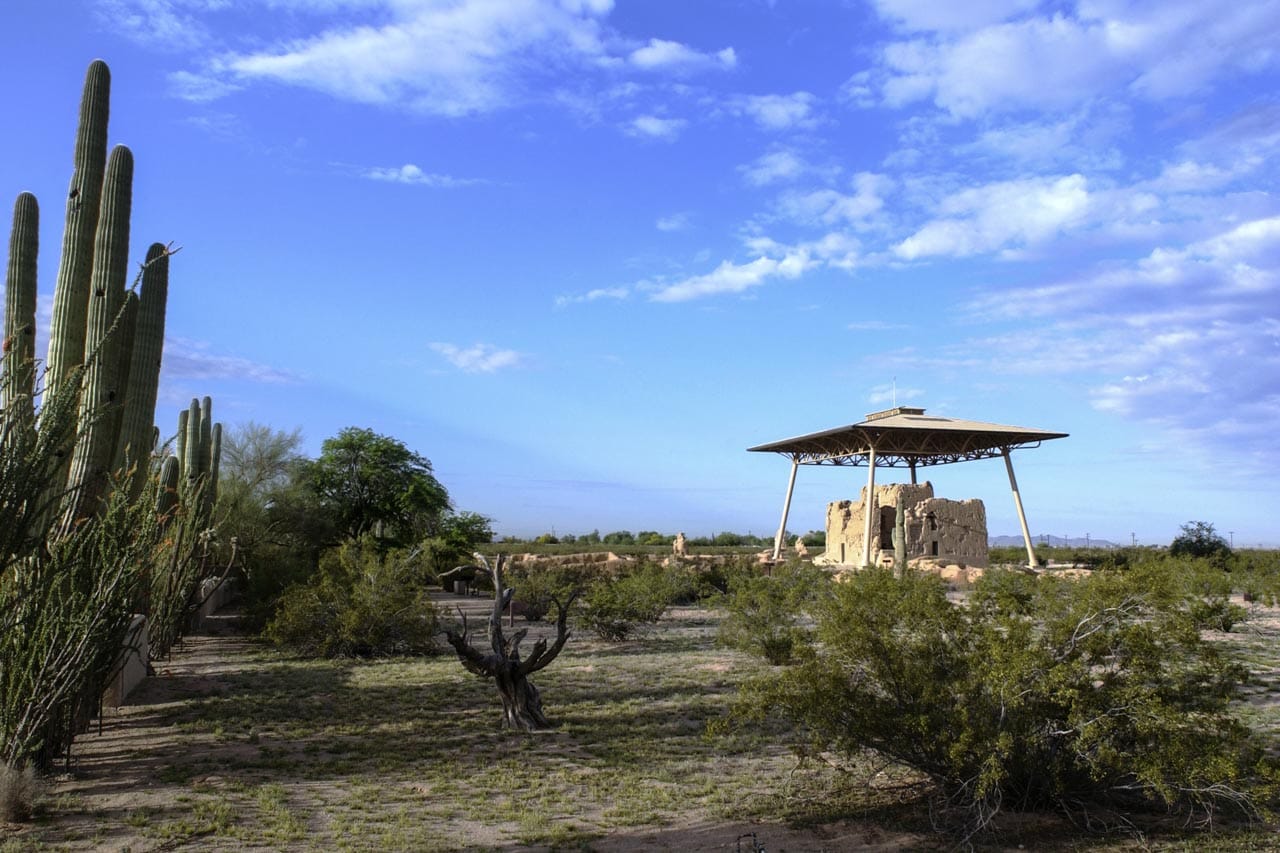
At Casa Grande Ruins National Monument in south-central Arizona, you can discover the intricacies and complexities of a large ancient network of irrigation canals and desert communities.
The national monument preserves a “Great House”—or “Casa Grande”—as well as a farming community of the Ancestral Sonoran Desert People, the Hohokam Culture. These people constructed extensive trade and water networks across the desert, which lasted for more than 1,000 years.
Part of the mystery of this amazing Native American heritage site in the Southwest, however, is that archaeologists haven’t yet figured out whether Casa Grande was just one of many landmarks in the Hohokam canal system or an important gathering place.
Casa Grande Ruins National Monument website: https://www.nps.gov/cagr/index.htm
Montezuma Castle National Monument, Arizona
Native American tribe(s): Hohokam, Sinagua, Hopi, Yavapai

“Would your house look this good 800 years from now?” asks the Montezuma Castle National Monument website. The answer is: probably not.
The ingenuity and skills of the Sinagua people who lived in Arizona from 1100 to 1425 AD are nothing short of impressive.
Although neither part of the monument’s name is correct—it is neither a castle, nor was it built by Aztec emperor Montezuma—Montezuma Castle is still one of the best-preserved cliff dwellings in North America.
Nestled high in a sheer limestone cliff along Beaver Creek, this magnificent masterpiece of ancient architecture is basically a 20-room high-rise apartment complex.
It’s a structure unlike anything else in the U.S., boasting a huge amount of floor space across no fewer than five stories, all of which was accessible via wooden ladders.
Montezuma Castle National Monument website: https://www.nps.gov/moca/index.htm
Wupatki National Monument, Arizona
Native American tribe(s): Ancestral Puebloans, Cohonina, Sinagua, Hopi, Navajo, Zuni
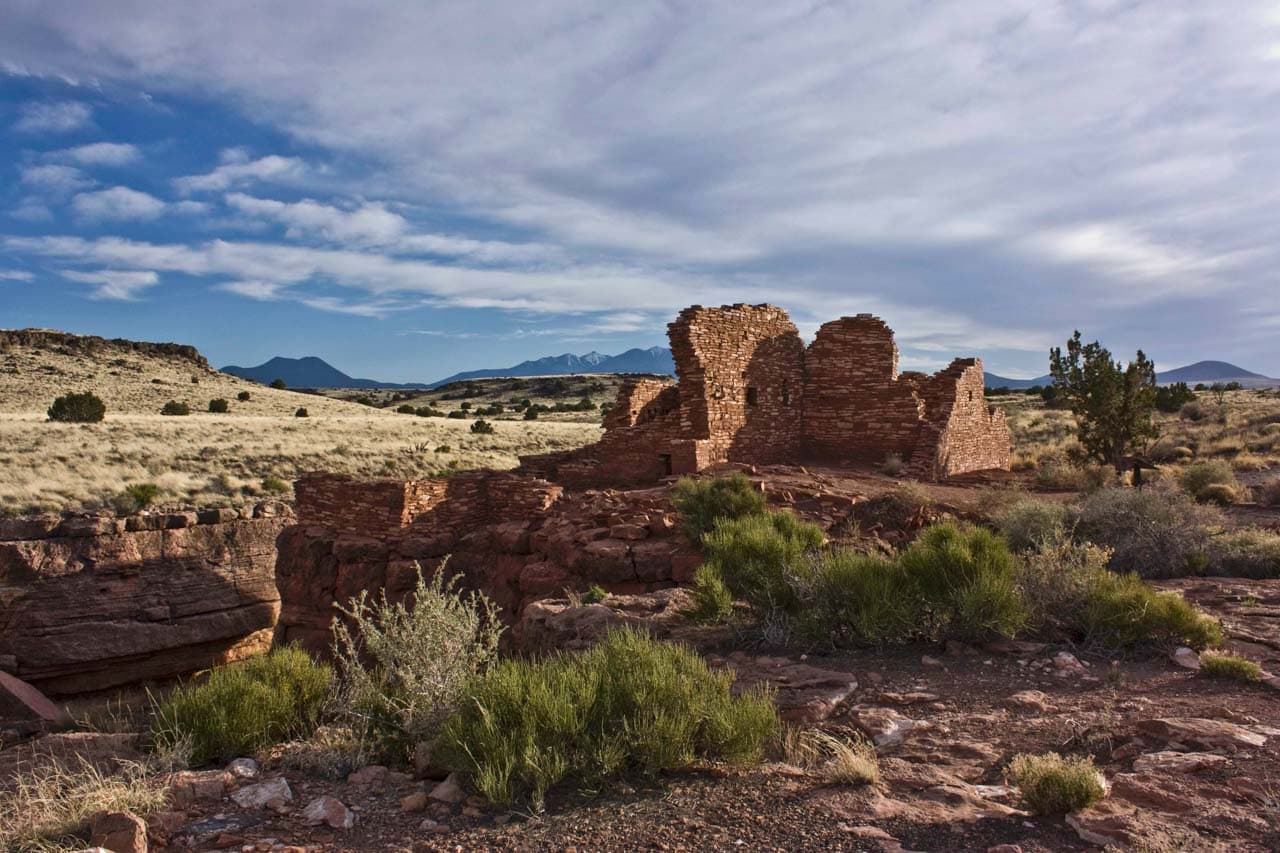
Situated between northern Arizona’s ponderosa highlands and the Painted Desert, Wupatki National Monument is a place filled with ancient Native American sites.
Here, centuries-old pueblos pepper red-rock buttes and many miles of plains and prairie.
The largest pueblo within the national monument is its namesake Wupatki Pueblo, an impressive 100-room dwelling. Other major point of interest include the Wukoki Pueblo, the Lomaki and Box Canyon Pueblos, and the Citadel and Nalahiku Pueblos.
One of the reasons people managed to thrive in these arid plains was the 11th-century Sunset Crater eruption, which covered the region with volcanic ash. This made the soil both more fertile and better able to hold water.
Therefore, if you visit Wupatki National Monument, I also strongly recommend visiting nearby Sunset Crater Volcano National Monument.
Wupatki National Monument website: https://www.nps.gov/wupa/index.htm
Gila Cliff Dwellings National Monument, New Mexico
Native American tribe(s): Mogollon Culture
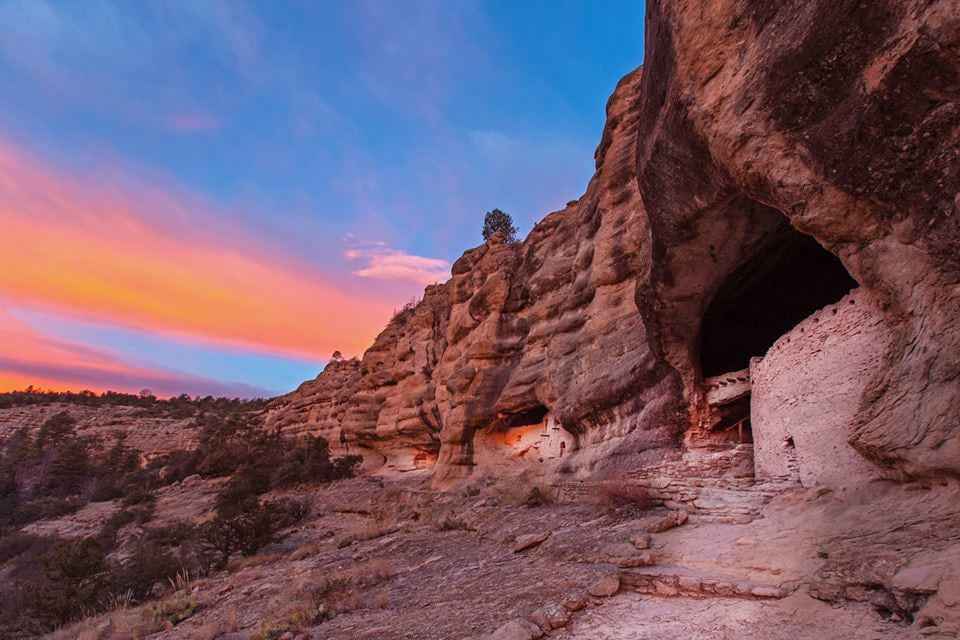
For countless millennia, bands of nomads wandered through the Gila River valley, using its caves as temporary shelters. That all changed in the late-13th century when the people of the Mogollon Culture choose the area as their permanent home.
During their short residence along the Gila River—they stayed only about 20 years—they constructed cave rooms and cliff dwellings, raised families and made pottery. Nowadays, Gila Cliff Dwellings National Monument contains two large ruins and several smaller sites.
Additionally, the Gila Wilderness, which lies adjacent to the Gila Cliff Dwellings, is the oldest wilderness in the world, designated in 1924.
It’s home to hundreds of miles of hiking and horseback riding trails, while camping and fishing are popular things to do as well.
Gila Cliff Dwellings National Monument website: https://www.nps.gov/gicl/index.htm
El Morro National Monument, New Mexico
Native American tribe(s): Ancestral Puebloans, Zuni
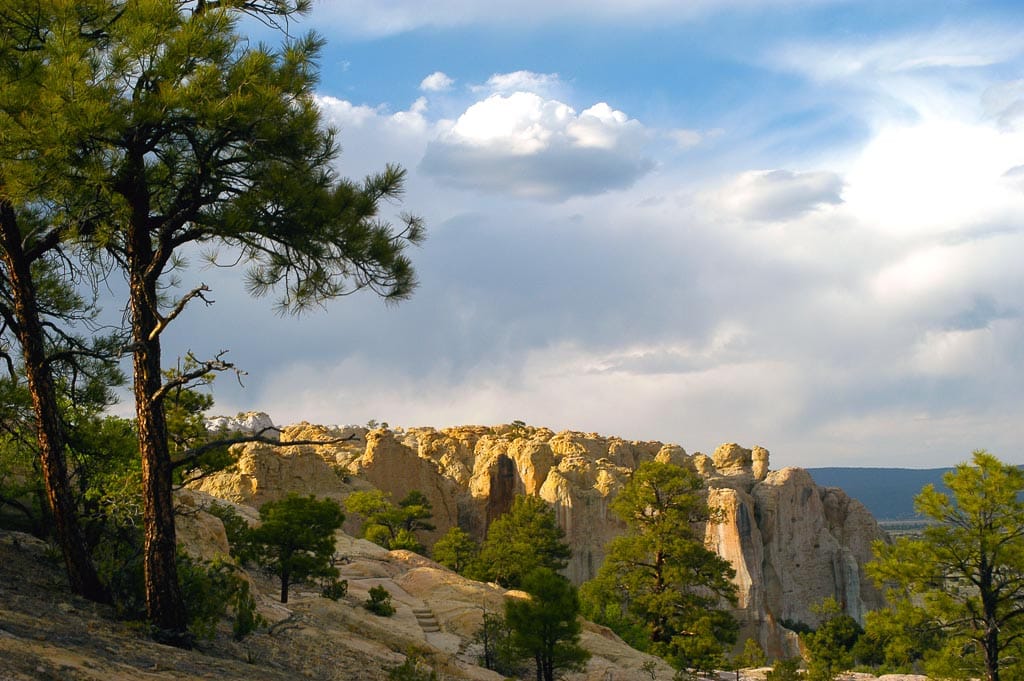
The commanding sandstone formation known as El Morro has guided people for many centuries. More than 700 years ago, Ancestral Puebloans built pueblos on El Morro and carved symbols and images into the rock.
Nowadays, the Zuni, whose ancestors constructed pueblos on top of El Morro, call this grand sandstone bluff Atsinna, a “place of writings on the rock.”
Atsinna, one of the largest pueblos built in the region, was a hub of trade and culture in the 13th century. Although the Ancestral Puebloans occupied Atsinna for only about 75 years, the site continues to be a sacred place among the Zuni people today.
Additionally, throughout the decades and centuries, a waterhole at the bluff’s base made it a popular stopping point for weary and thirsty travelers.
In the 16th century, Spanish expeditions made their way into the area in search of gold and silver and to establish missions. This resulted in the first official historic record of El Morro.
A particularly significant exploration was the one by Don Juan de Onate in 1598. Bringing 400 colonists and 10 Franciscans into what is now New Mexico, he effectively founded the first European colony in New Mexico.
Soon after, though, traveling soldiers, priests and governors added their own inscriptions while traveling to the western pueblos.
Even though they’re short, small notes and carvings in rock, the many inscriptions at El Morro National Monument provide a valuable insight into Native American, Hispanic and American history in New Mexico.
El Morro National Monument website: https://www.nps.gov/elmo/index.htm
Pecos National Historical Park, New Mexico
Native American tribe(s): Ancestral Puebloans
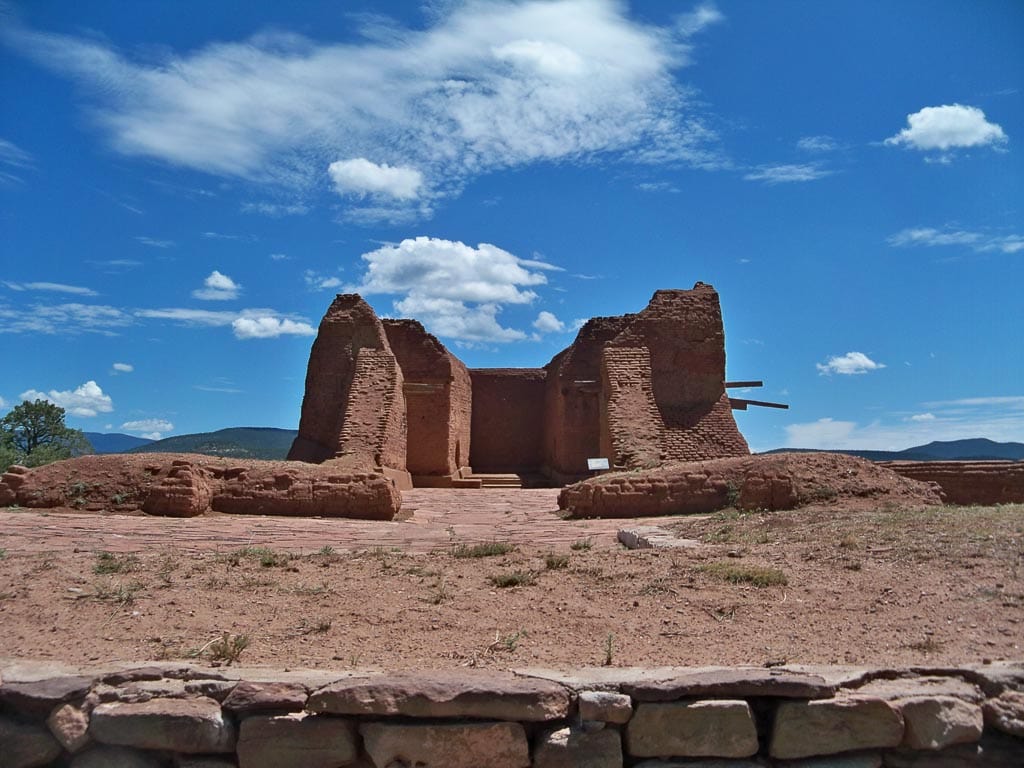
For many thousands of years, the Pecos Valley in New Mexico has been the home of many different peoples.
“Pueblo and Plains Indians, Spanish conquerors and missionaries, Mexican and Anglo armies, Santa Fe Trail settlers and adventurers, tourists on the railroad, Route 66 and Interstate 25… the Pecos Valley has long been a backdrop that invites contemplation about where our civilization comes from and where it is going.”
– National Park Service
Pecos National Historical Park sits in a verdant valley near the Sangre de Cristo Mountains, a fertile area that allowed for the growing of crops. Native communities expanded and grew into dozens of pueblos, which ultimately got consolidated into the large Pecos Pueblo by 1450.
The 17th century marked the arrival of the Spanish. Pecos Pueblo had become well-known throughout the region by then, attracting Spanish soldiers looking for resources and missionaries looking to spread Catholicism.
The Spanish started founding a colony and Franciscan missions in the Pecos Valley. This was their way to establish complete control over the Puebloans, including control over the local economy and belief systems.
The Puebloans, however, didn’t agree with this approach at all. In 1680, they banded together and started what effectively was the very first American Revolution.
Led by Po’pay from the San Juan Pueblo, the Pueblo Revolt was successful. It was the only time in history that Native Americans successfully expelled European invaders.
The Spanish came back with a vengeance in 1692, though, finding little resistance from a Pecos Pueblo population suffering from European diseases and Comanche raids. Numerous missions were re-established near the area’s pueblos.
Later on, the legendary Santa Fe Trail opened in 1821 after Mexico became independent from Spain, passing right through Pecos Pueblo and its Spanish missions. This added yet another layer of historic importance to this fascinating place.
Pecos National Historical Park website: https://www.nps.gov/peco/index.htm
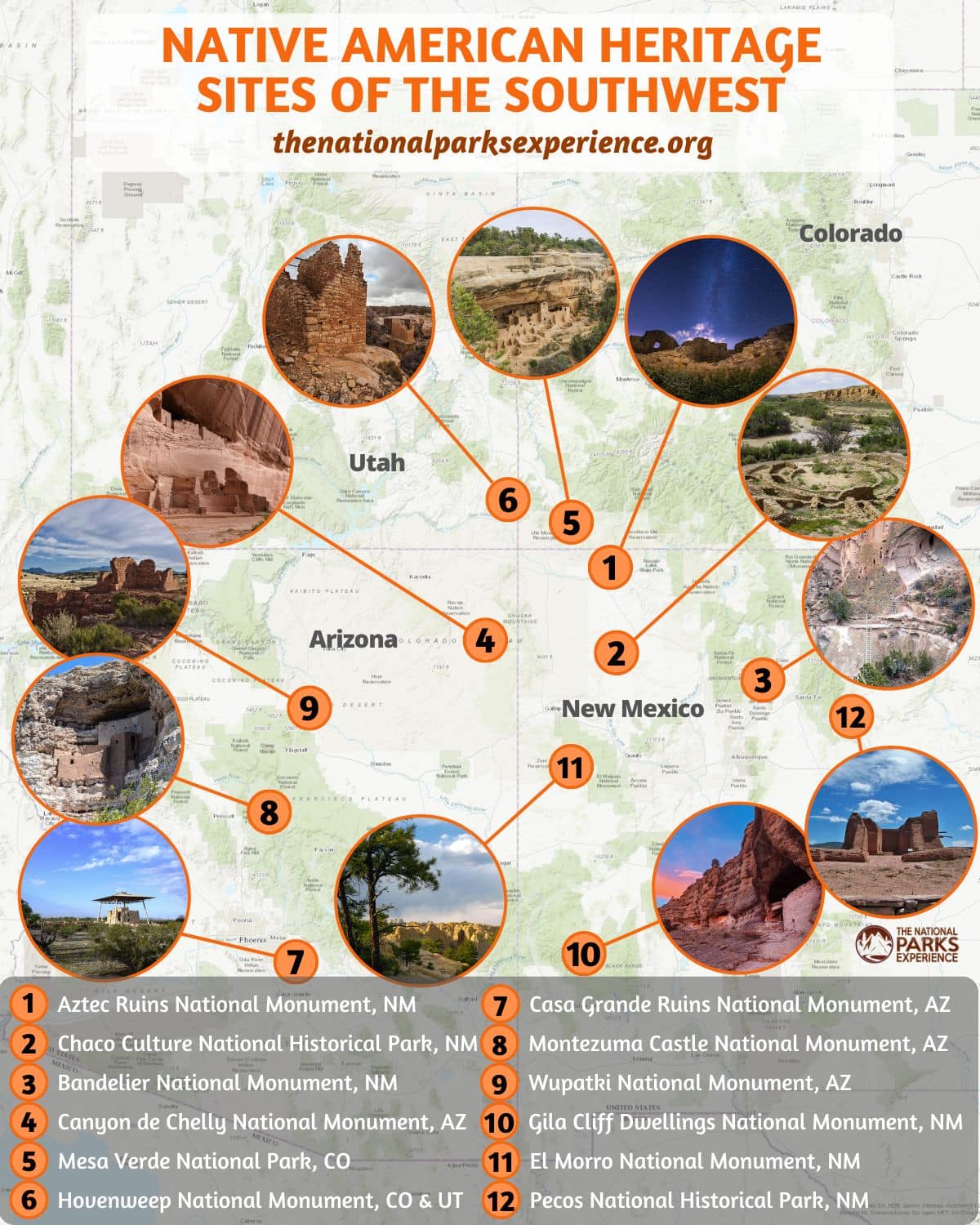
Other Southwest National Parks with Native American Sites
- Petroglyph National Monument, New Mexico – Ancestral Puebloans
- El Malpais National Monument, New Mexico – Ancestral Puebloans, Acoma, Laguna, Zuni, Navajo
- Navajo National Monument, Arizona – Ancestral Puebloans
- Walnut Canyon National Monument, Arizona – Hohokam, Sinagua
- Tuzigoot National Monument, Arizona – Hohokam, Sinagua
- Tonto National Monument, Arizona – Salado Culture
Native American Heritage Sites of the Great Plains
In the early-1800’s, the Great Plains formed a seemingly impassable barrier of hundreds of miles of rolling prairie. This so-called “Great American Desert” divided the densely populated East and the riches California and the Oregon Territory.
This all changed with the blazing of now-legendary emigrant trails, such as the Oregon, Santa Fe and Mormon Trails, which ran right through prime Native American hunting grounds. After the Civil War, the railroad and the slaughter of the buffaloes changed the Great Plains forever.
Many of the national parks with Native American heritage sites in the Great Plains are related to 19th-century events and characteristics, from battles to trading posts. Some, however, also preserve important Native American cultural sites and landmarks.
To foreigners, which included 19th-century Euro-Americans in the East as well as modern-day westerners, the Plains Indians symbolize the classic image of the “Indian.”
These were the people who lived in teepees, hunted bison, smoked ceremonial pipes, performed days-long dances, had a horse culture, and wore (war) paint and feathers.
The reason why tribes like the Cheyenne, Lakota/Dakota (Sioux), Arapaho, Kiowa, Comanche and Apache have become so iconic is, of course, because of their unrelenting resistance against the westward expansion of white culture.
It’s no surprise that the most famous Native American warriors to this day belonged to the Great Plains tribes. Geronimo, Crazy Horse, Sitting Bull and Red Cloud are legendary names from the 19th-century Indian Wars.
Little Bighorn Battlefield National Monument, Montana
Native American tribe(s): Lakota (Sioux) and Northern Cheyenne
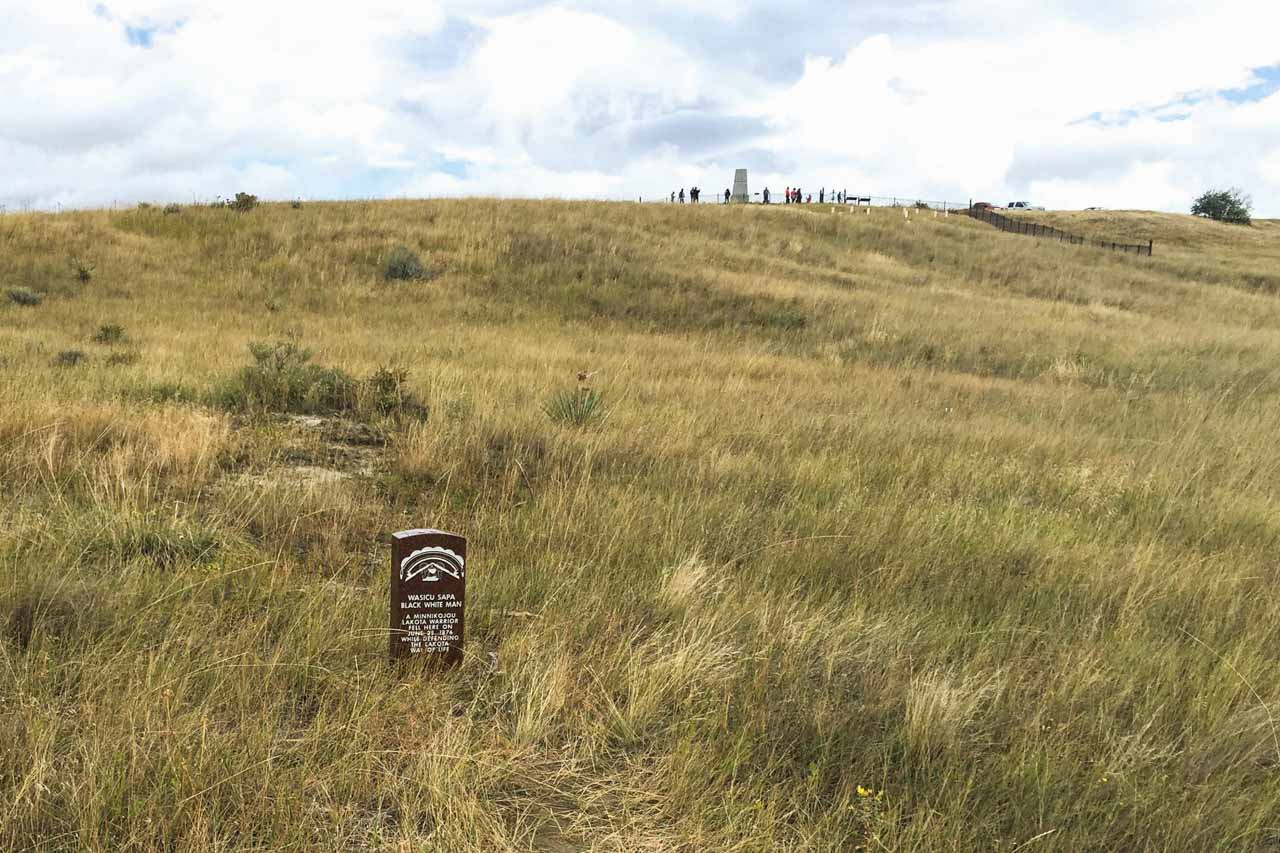
Little Bighorn Battlefield National Monument near the Crow Agency in Montana preserves the place where a force of Lakota and Cheyenne warriors defeated the 7th Cavalry of the U.S. Army under the command of George Armstrong Custer
During the Battle of the Little Bighorn, called the Battle of the Greasy Grass by the Plains Indians, more than 250 U.S. Army soldiers died along with an unknown number of Native Americans.
Although it was a significant momentary victory for the people of Sitting Bull, Crazy Horse and numerous other prominent leaders, it did result in massive action by the U.S. government to force Native Americans onto reservations.
Within a year after the Battle of Little Bighorn, virtually all Native American participants had either fled, died or surrendered.
Nowadays, this national monument consist of a number of memorials, including the Indian Memorial, the Memorial Obelisk, and numerous U.S. casualty and Indian combatant markers.
It also contains the Custer National Cemetery, while the Tour Road allows you to retrace the course of this epic battle.
Little Bighorn Battlefield National Monument website: https://www.nps.gov/libi/index.htm
Knife River Indian Villages National Historic Site, North Dakota
Native American tribe(s): Hidatsa, Mandan and Arikara

Arguably the most important Native American historic site in North Dakota, this area was home to the Hidatsa and Mandan tribes.
This collection of earth-lodge villages near the confluence of the Knife and Missouri Rivers thrived as a trading hub in west-central North Dakota.
The hospitable Hidatsa people welcomed visitors to their villages for hundreds of years. People came here from far and wide, for their high-quality products such as moccasins, buffalo hides, flint, tools and even produce.
The Hidatsa and Mandan Indians operated a trade center where foreign products from all over North America were exchanged, from as far away as Hudson Bay, present-day Montreal and St. Louis.
Other Plains Indian tribes like the Cheyenne, Arapaho, Comanches and Kiowa also came here to exchange products.
Additionally, the Knife River Villages were the home of Sacagawea. She lived there when she met the Lewis and Clark Expedition. Because she understood the Shoshone language, was familiar with parts of the expedition’s intended route and married to a French fur trader, who was to serve as a guide on the expedition, she was asked to join, too.
Even though she was only 17 years old at the time, her presence proved crucial to the success of this legendary expedition.
Nowadays, the Knife River Indian Villages National Historic Site encompasses the remains of the Awatixa Xi’e Village (the Lower Hidatsa Site), the Awatixa Village (Sakakawea Site) and the Hidatsa Village (the Big Hidatsa Site).
A major attraction is the reconstructed full-scale Earthlodge, complete with drying racks and a Hidatsa garden. There are hiking trails and a great museum, too.
Knife River Indian Villages National Historic Site website: https://www.nps.gov/knri/index.htm
Badlands National Park, South Dakota
Native American tribe(s): Lakota (Sioux)

Located in southwestern South Dakota, Badlands National Park consists of a maze of eroded hills, buttes and pinnacles, which contain one of America’s richest fossil deposits. The park also preserves the largest pristine mixed-grass prairie in the United States.
The park is managed by the National Park Service, while the South Unit, also known as the Stronghold District, lies on the Pine Ridge Indian Reservation and is co-managed by the Oglala Lakota (or Sioux), one of the most famous Great Plains tribes.
Well-known Oglala Lakota included Black Kettle, Young-Man-Afraid-of-His-Horses and Black Elk. The most renowned Oglala Lakota, however, were unquestionably legendary war leaders Crazy Horse and Chief Red Cloud.
The latter gained both respect and notoriety in the East for forcing the U.S. Army to sue for peace during Red Cloud’s War (1866-1868), the first and only Native American leader to defeat the U.S. Army in a war.
Badlands National Park’s Stronghold District contains Ghost Dance sites, which took place toward the end of the Indian Wars in the 1890’s. Additionally, the Pine Ridge Reservation also encompasses Wounded Knee Creek.
Situated just south of the Badlands National Park boundary, this is the location of the infamous 1890 Wounded Knee Massacre during which hundreds of Miniconjou Lakota of Chief Spotted Elk’s band, most of them women and children, were massacred by the U.S. Army.
Although the Stronghold District has very few roads and is nearly entirely private Lakota land, you can still visit some parts of it after obtaining permission from private landowners.
The park’s North Unit is much easier to visit and can also give you some insight into the lives of the Great Plains Indians. There are plenty of things to do in Badlands National Park. You can drive or mountain bike the Scenic Drive, enjoy spectacular Badlands sunrises, and watch for iconic wildlife, such as American bison, prairie dogs and bighorn sheep.
Badlands National Park website: https://www.nps.gov/badl/index.htm
Wind Cave National Park, South Dakota
Native American tribe(s): Lakota (Sioux), Northern Cheyenne, Kiowa, Ponca, Northern Arapaho, and more
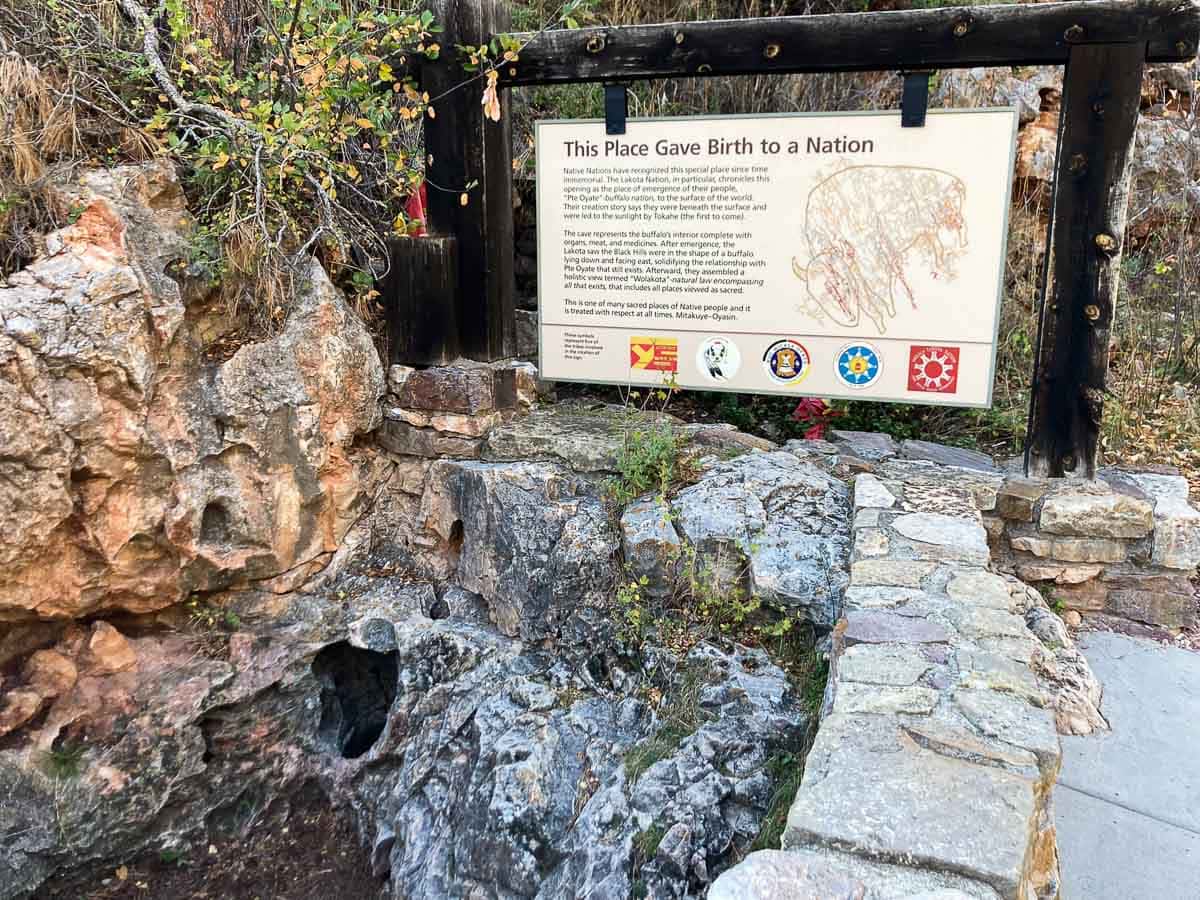
The Wind Cave in the Black Hills of South Dakota plays a major role in the Lakota Emergence Story. Called “Breathing Earth” in modern-day Lakota, the cave is remarkable because it actually does appear to inhale and exhale.
The Lakota consider Wind Cave a sacred place, the very place from which they emerged from the underworld. In their origin story, the cave is a passageway containing a portal to the spirit lodge and spirit world.
In addition to this spiritual aspect, Wind Cave National Park is also a natural wonder.
One of the oldest U.S. national parks and the world’s first cave to be designated a national park, it’s noteworthy for its boxwork and frostwork. Wind Cave contains no less than 95% all of known boxwork formations on Earth!
It’s also one of the longest and most complex cave systems in the world, boasting a massive maze of passageways. Above ground, unspoiled mixed-grass prairie is home to an abundance of Great Plains wildlife, including elk, American bison, pronghorn antelope and prairie dogs.
Wind Cave National Park website: https://www.nps.gov/wica/index.htm
Pipestone National Monument, Minnesota
Native American tribe(s): Lakota (Sioux), Omaha, Ponca, Mandan, Shoshone, Sac and Fox, Otoe-Missouria, and more
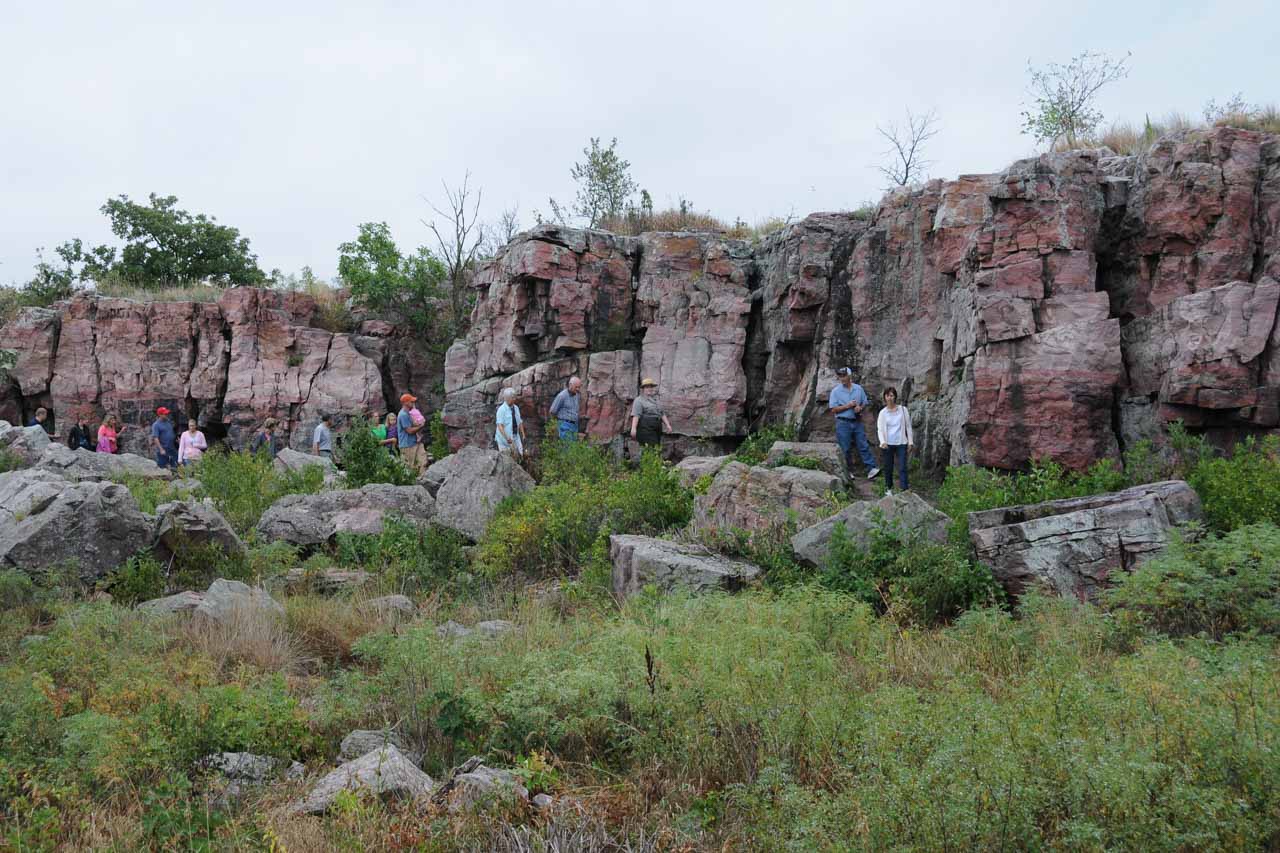
“When you pray with this pipe, you pray for and with everything.”
Black Elk
Native Americans quarried the red pipestone in this area for numerous generations.
A sacred area to many North American tribes, it was considered neutral territory where all people could come and mine stone to make ceremonial pipes, often wrongly called “peace pipes” by White settlers.
A valued resource, pipestone from this site has been found in burial mounds and other archaeological Native American sites hundreds of miles away.
The smoke from these pipes is/was believed to carry a person’s prayers to the Great Spirit. People used these pipes for a variety of purposes, from ceremonial commitments to sealing treaties and religious prayers.
Ceremonial pipes one of the greatest symbols of Native American culture(s). As such, this is one of the most significant Native American heritage sites, especially because quarrying and pipe-making traditions continue to this day on the site.
Pipestone National Monument website: https://www.nps.gov/pipe/index.htm
Devils Tower National Monument, Wyoming
Native American tribe(s): Lakota (Sioux), Northern Cheyenne, Shoshone, Crow, Kiowa, Arapaho, and more

Established by Theodore Roosevelt in 1906 as the very first national monument in America, Wyoming‘s Devils Tower National Monument is centered on a massive butte of magmatic rock.
This amazing geological feature is the world’s largest example of “columnal jointing”, a towering landmark of solid rock that protrudes from the prairie around the Black Hills.
The Native American name for Devils Tower varies from “Bear’s House” and “Bear’s Lodge” to “Tree Rock” and “Aloft on a Rock.”
Many mythical stories of several tribes, including the Lakota, Kiowa, Cheyenne, Arapaho and Crow, are related to this striking formation. Almost all of them involve a giant bear clawing at the rock to reach people at the top.
Devils Tower National Monument website: https://www.nps.gov/deto/index.htm
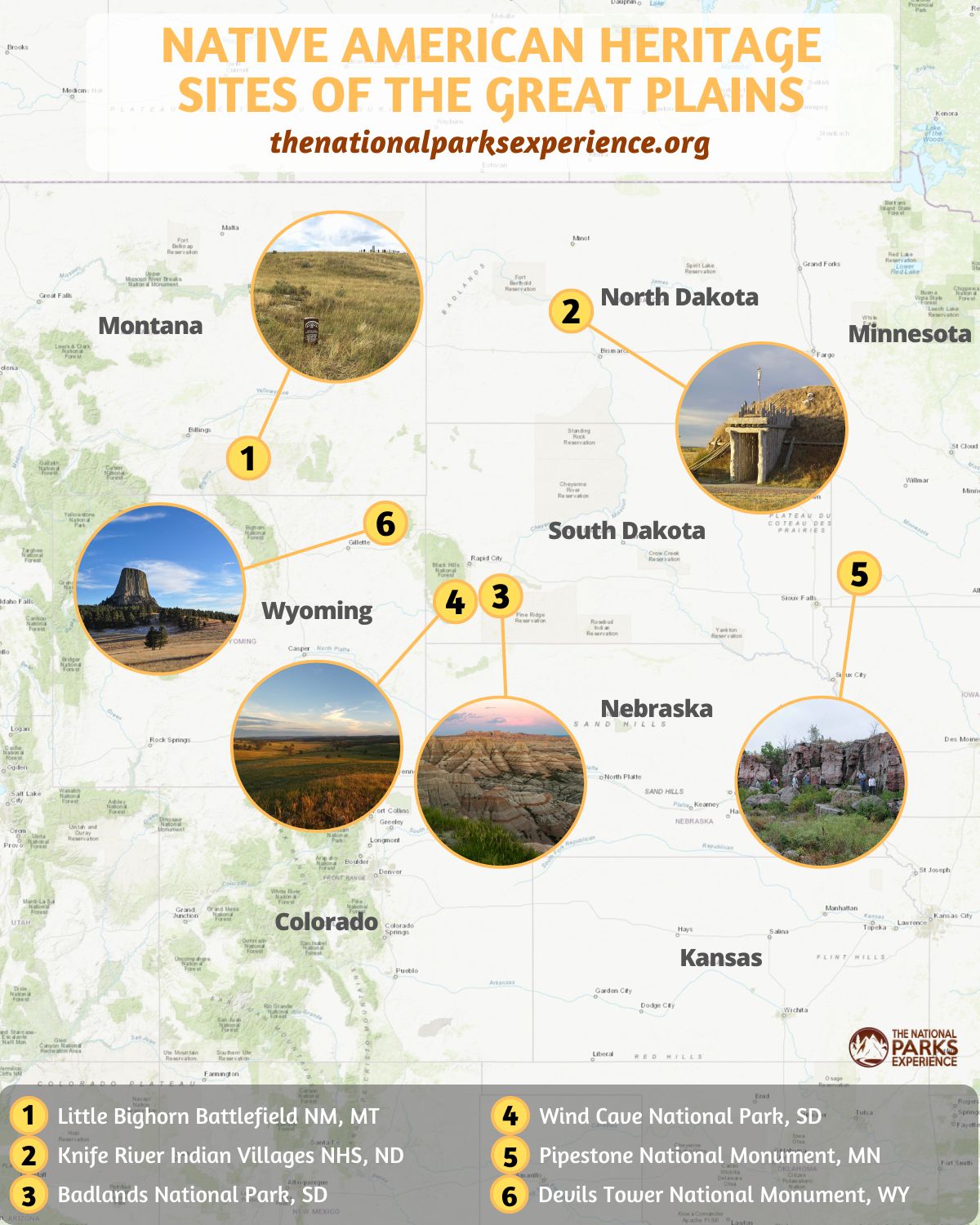
Other Great Plains National Parks with Native American Sites
- Sand Creek Massacre National Historic Site, Colorado – Southern Cheyenne and Arapaho
- Bent’s Old Fort National Historic Site, Colorado – Southern Arapaho, Southern Cheyenne, Comanche, and Kiowa
- Fort Union Trading Post National Historic Site, North Dakota – Assiniboine, Crow, Blackfeet, Plains Cree, Ojibwe, Mandan, Hidatsa, Arikara, and Lakota (Sioux)
Native American Heritage Sites of the Pacific Northwest & Alaska
Although the Native American tribes of the Pacific Northwest and Alaska may be less known than the Plains Indians or the Ancestral Puebloans, they do have some famous cultural traditions and features.
Having occupied the mountains, rain forests and rugged coasts of Oregon, Washington, British Columbia and Alaska for millennia, these people live(d) in a diverse environment with lots of food sources, from elk to fish and seafood.
This abundance of food and other natural resources allowed them to develop highly structured and complex cultures with one of the densest Native American population densities in North America.
Many different nations originated, including the Tlingit, the Coast Salish, the Chinook and the Tillamook.
A central theme in their cultures is the seasonal salmon migration, as well as farming and cultivation practices. But most of all, the Native American tribes of the Pacific Northwest and Alaska are famous for their totem poles.
These tall carved poles serve(d) as a way to pass on stories, wisdom and history from one generation to the next. Another major cultural characteristic of these tribes was/is the potlatch, a complex gathering of tribes, involving music, dance and ceremonies.
Nez Perce National Historical Park, Idaho, Montana, Washington and Oregon
Native American tribe(s): Nez Perce
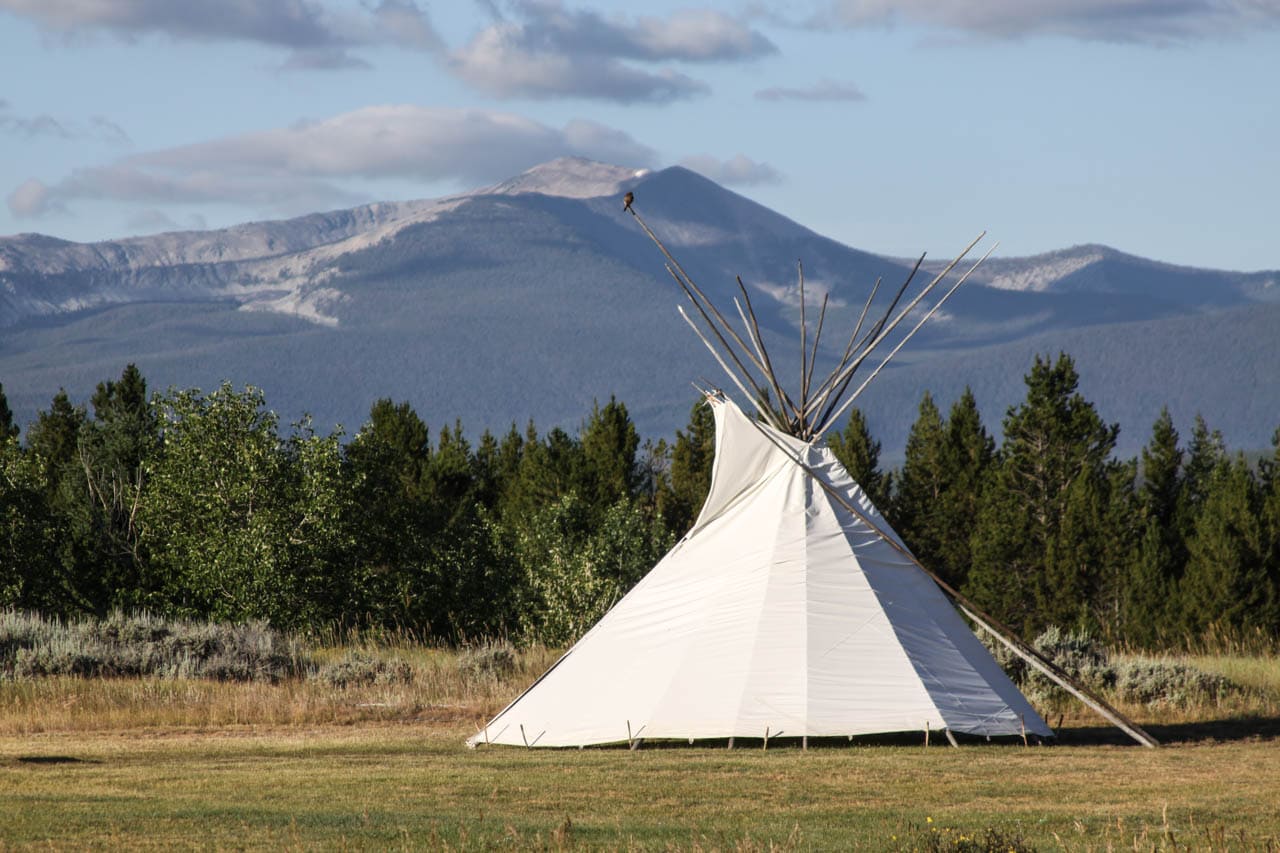
Comprised of almost 40 individual sites in Idaho, southwestern Washington, northeastern Oregon and Montana, Nez Perce National Historical Park tells the complicated story of the resilient Nez Perce people.
Having lived and thrived in the mountains, valleys, plateaus and prairies of the inland Pacific Northwest for millennia, their way of life was severely uprooted in the mid-1800’s with the arrival of white settlers from the East (who arrived mainly via the Oregon Trail).
The Nez Perce are perhaps best known for their epic Flight of 1877. During this moving war, non-treaty Nez Perce led by Chief Joseph, Looking Glass, White Bird and others traveled 126 days and 1,170 miles across four states to escape the pursuing U.S. Army.
Famously, they also spent 13 days crossing Yellowstone National Park, which had been established as the world’s first national park just a few years earlier.
Many of the sites that make up Nez Perce National Historical Park retrace the course of this journey, including battlefields, skirmish sites and campsites.
Nez Perce National Historical Park website: https://www.nps.gov/nepe/index.htm
Sitka National Historical Park, Alaska
Native American tribe(s): Tlingit

Sitka National Historical Park highlights the often-forgotten Russian history in North America. The park preserves a battle site where native Tlingit and Russian traders clashed.
Another top attraction is the Russian Bishop’s House, built for a Russian Orthodox bishop by Tlingit laborers, overseen by Finnish builders.
It is one of only four surviving Russian Colonial-style buildings in the Western Hemisphere and offers a great insight into the little known Russian colonial legacy in North America.
That said, Sitka National Historical Park’s premier highlight is its totem poles. You can admire this collection of impressive totem poles along peaceful woodland trails, and see a powerful symbol of the native cultures of Alaska.
Sitka National Historical Park website: https://www.nps.gov/sitk/index.htm
Glacier Bay National Park, Alaska
Native American tribe(s): Tlingit

Encompassing the ancestral homelands of the Tlingit people, Alaska’s remote Glacier Bay National Park is another amazing park to learn about Native Alaskan culture and history.
While Glacier Bay is now a deep fjord dotted with islets and flanked by towering mountains, just a few hundred years ago, it was “a verdant valley coursing with salmon-rich streams and scattered forests.” Then, around 1750, a giant glacier advanced, forcing the Tlingit from their homes.
Nowadays, the glacier has retreated again, leaving behind an enormous bay. The Tlingit people returned and claim Glacier Bay as their spiritual homeland. At Bartlett Cove, the only place in the park that’s accessible by road, you can learn more about the fascinating Tlingit culture.
Visit the museum at Glacier Bay Lodge, walk the wonderful Tlingit Trail to see totem poles, a traditional canoe, and a huge humpback whale skeleton.
The main highlight, however, is the Xunaa Shuká Hít (also known as the Huna Tribal House). It serves as a gathering place for tribal members, as well as place where visitors can learn more about the Tlingit’s ways of life.
Glacier Bay National Park website: https://www.nps.gov/glba/index.htm

Native American Heritage Sites of the Midwest
The Native American tribes most often associated with the Midwest include the Chippewa, Kickapoo, Illinois, Iroquois, Miami, Shawnee and others.
However, the sites preserved by the Native American heritage national parks below predate these modern tribes by (many) hundreds of years.
Both parks preserve prehistoric earthen mounds that were built in the valleys, grasslands and woodlands along the Mississippi and Ohio Rivers.
The people who lived in these fertile plains and forests, collectively called Mound Builders, were connected to each other by trade routes and networks, with extended as far as present-day New York State and Georgia (see further down).
Effigy Mounds National Monument, Iowa
Native American tribe(s): Hopewell Culture, Effigy Moundbuilders, Iowa, Sac and Fox, Ho-Chunk, Winnebago, Omaha, Standing Rock Sioux, Upper Sioux, and more

Preserving no fewer than 200 prehistoric mounds, Effigy Mounds National Monument is one of the most important national parks with Native American heritage sites.
Most of these mounds were shaped like animals (effigies), which was a cultural tradition typical for this region along the Upper Mississippi.
They resembled common woodland and grassland animals like bears, bison, deer, birds and lynx. In addition to these animal-shaped mounds, there were also rectangular and linear mounds. To this day, their purpose remains unclear.
The national monument features hiking trails, ranger programs and a visitor center, all of which can give you a deeper insight into the lives and traditions of the Effigy Moundbuilders.
Effigy Mounds National Monument website: https://www.nps.gov/efmo/index.htm
Hopewell Culture National Historical Park, Ohio
Native American tribe(s): Hopewell Culture
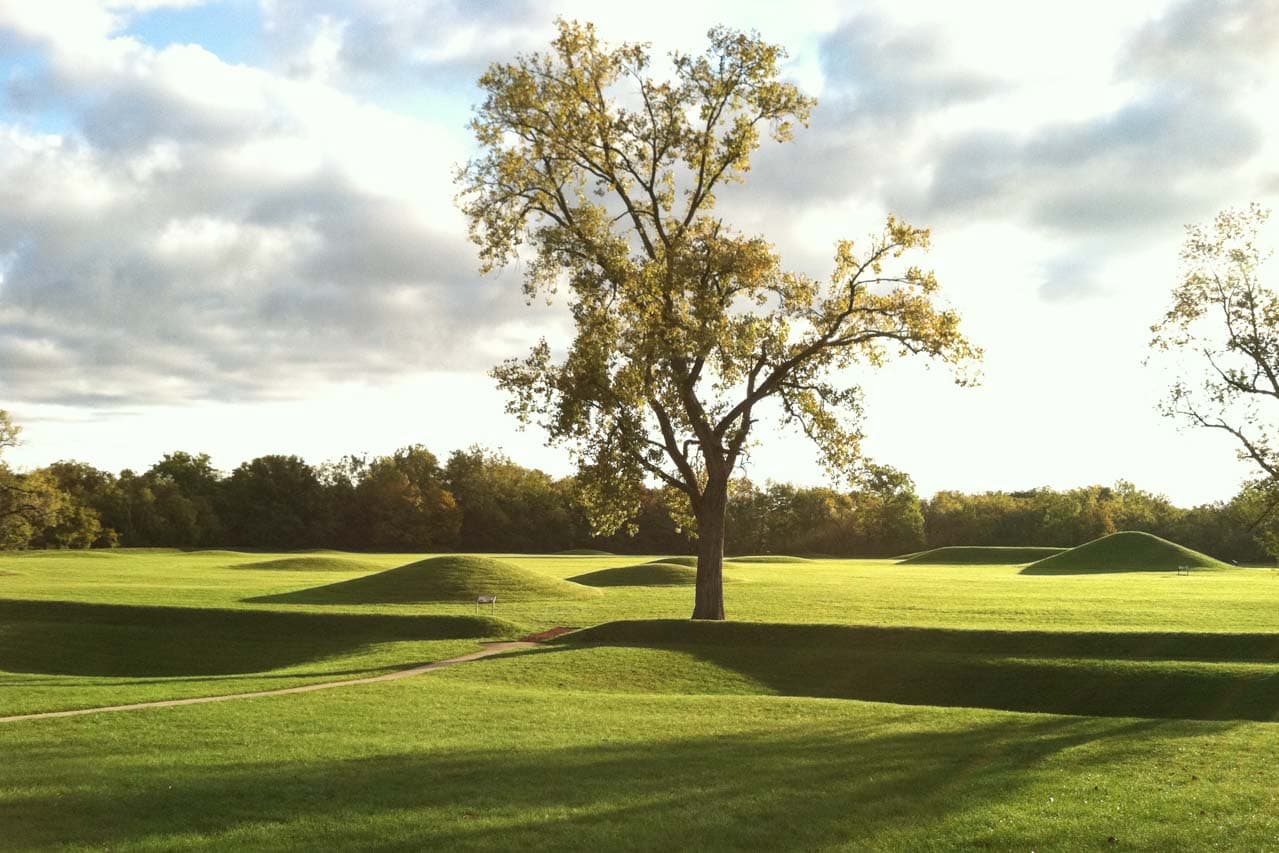
Similar to the Effigy Mounds above, Hopewell Culture National Historical Park also preserves a collection of earthen mounds and embankments.
Situated in the Ohio River Valley, they were constructed between 200 and 500 AD by the prehistoric people of the Hopewell Culture.
These massive mounds have the form of circles, squares and other geometric shapes, many of them of a monumental scale. Several have earthen walls up to 12 feet high and are 1,000 feet across. There are also conical mounds as high as 30 feet.
The Hopewell Culture National Historical Park in south-central Ohio contains six different groups of earthwork complexes: the Hopewell Mound Group, Mound City Group, Hopeton Earthworks, High Bank Works, Spruce Hill Earthworks and Seip Earthworks.
Hopewell Culture National Historical Park website: https://www.nps.gov/hocu/index.htm
Grand Portage National Monument, Minnesota
Native American tribe(s) : Ojibwe
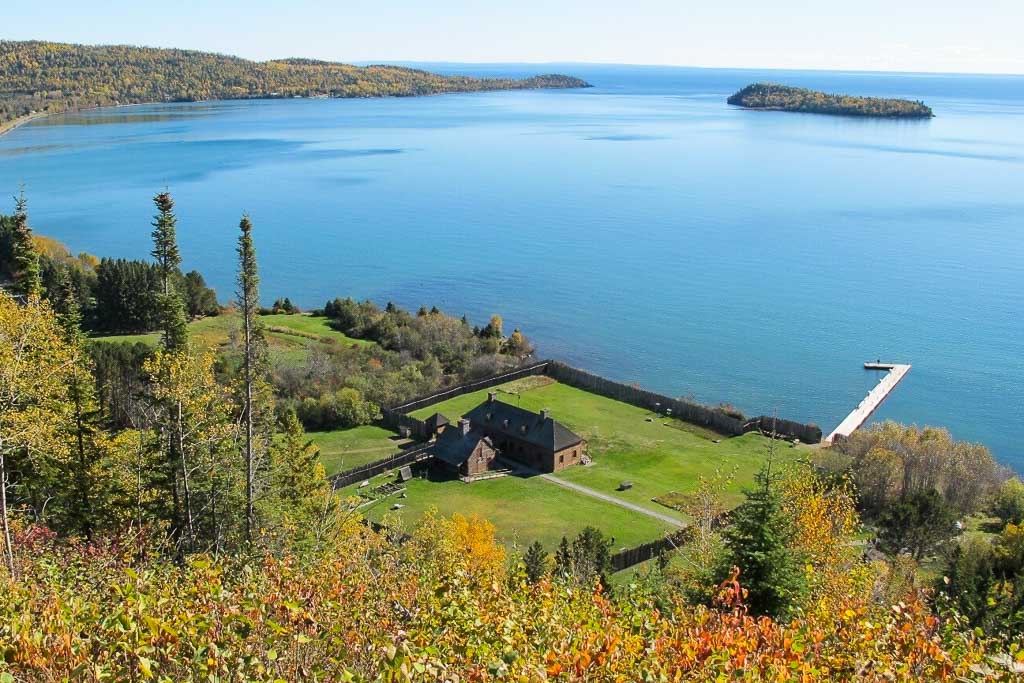
Situated on the shore of Lake Superior in the far northeastern corner of Minnesota, Grand Portage National Monument offers an insight into the lives of the Anishinaabeg Ojibwe and the voyageurs and coureurs des bois of the North West Company.
During the heydays of the 19th-century fur trade, this area bustled with activity. Crossed by historic trade routes, it was one of the four main fur trading centers of the British Empire in North America. (The others were Michilimackinac, Fort Detroit and Fort Niagara.)
The Grand Portage, after which this national monument is named, was an 8.5-mile trail that bypassed rapids and waterfalls between Lake Superior and the Pigeon River. It still exists in its original location and condition to this day.
While this description might imply that it’s mainly a Euro-American site, Grand Portage National Monument also very much focuses on the lives, culture and heritage of the area’s Ojibwe, once the most powerful Native American tribe on the Great Lakes.
These people lived in the Grand Portage region for generations, building networks of trails and trade routes, creating beautiful art and artifacts, and generally thriving on the bountiful shores of Lake Superior.
The collections at Grand Portage National Monument includes numerous items of 20th-century Minnesota Ojibwe artwork, from porcupine quillwork and cedar bark mats to floral beaded gauntlets, belts and headbands.
Grand Portage National Monument website: https://www.nps.gov/grpo/index.htm
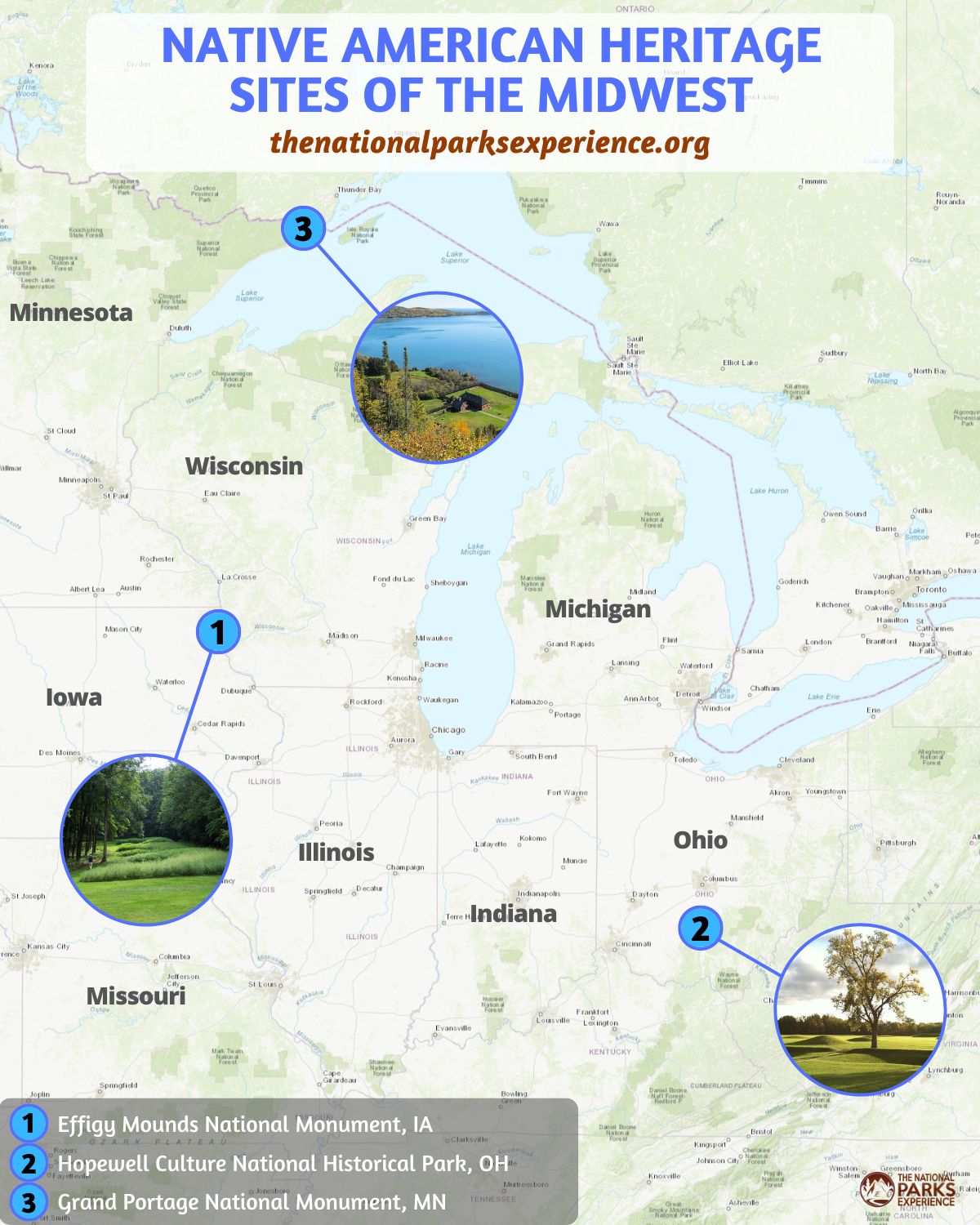
Native American Heritage Sites of the Southeast
Unlike in the Southwest or Great Plains, there are relatively few Native American heritage sites in the Southeast. A logical explanation would be the scouring of the region by white Euro-European settlers.
In the 18th and 19th centuries, they basically removed all things related to Native American culture from the region. This included the people themselves, most notoriously along the Trail of Tears.
However, there are still a few National Park Service sites that preserve Native American heritage in the Southeast. But they do not contain any traces of modern Southeast Native American tribes, such as the Cherokee, Seminole, Creek or Chickasaw.
Rather, they preserve prehistoric remains from long before first contact with Europeans, from earthen mounds to millennia-old archaeological sites.
Ocmulgee Mounds National Historical Park, Georgia
Native American tribe(s): Macon Plateau and Lamar Cultures
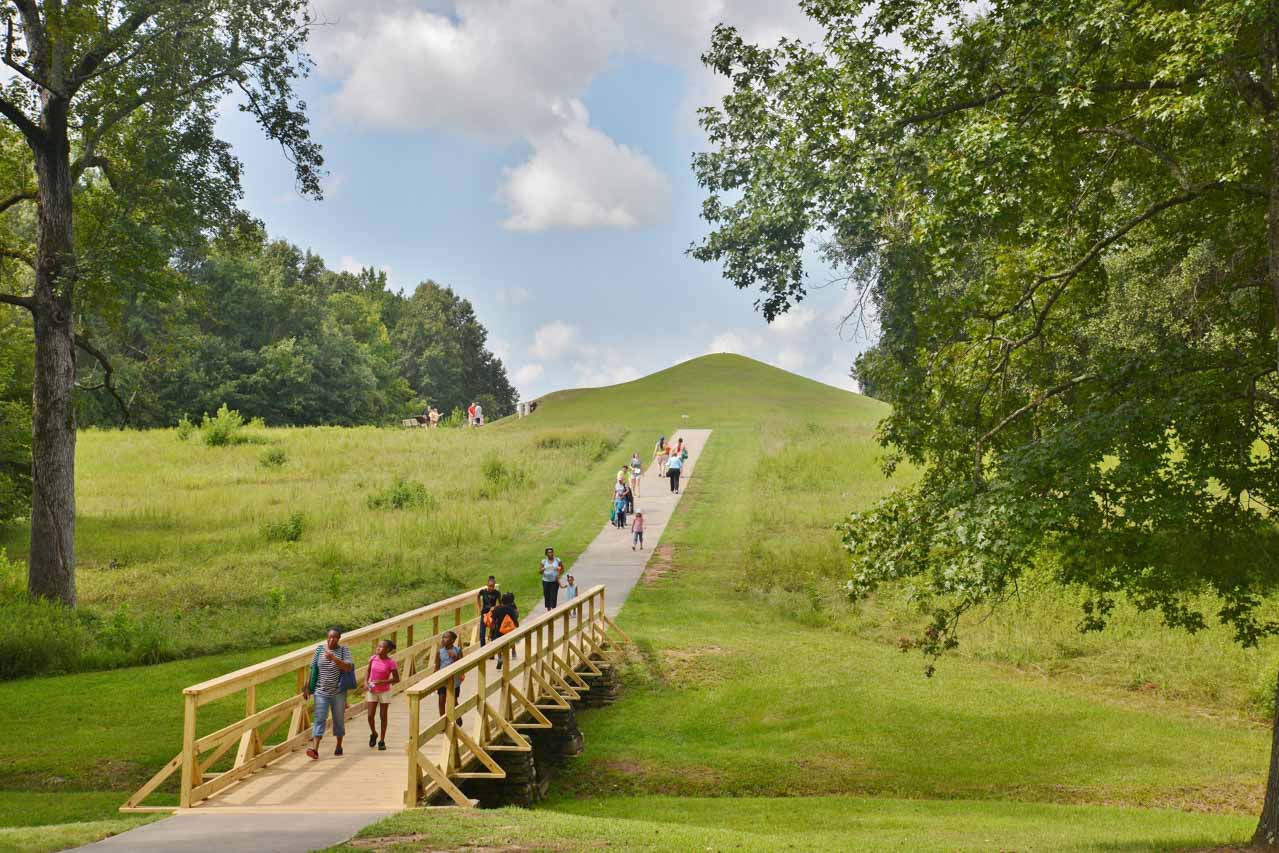
Although younger than the mounds in Iowa and Ohio above, the Ocmulgee Mounds are pretty similar in appearance.
They were built between roughly 900 and 1550 AD by the Macon Plateau Culture and subsequent Lamar Culture, which were part of the wide-spread Mississippian Culture.
These cultures constructed huge earthen mounds for their elite, many of which survive to this day. Ocmulgee Mounds National Historical Park in central Georgia preserves three main landmarks: the huge Earth Lodge, the Trading Post Site, and the Lesser and Great Temple Mounds.
Short hiking trails also lead to smaller Native American heritage sites in the park, including the Hitchiti Village Site and the Corn Field Mound.
Ocmulgee Mounds National Historical Park website: https://www.nps.gov/ocmu/index.htm
Russell Cave National Monument, Alabama
Native American tribe(s): Archaic hunter-gatherers to Woodland Culture and Mississippian Culture
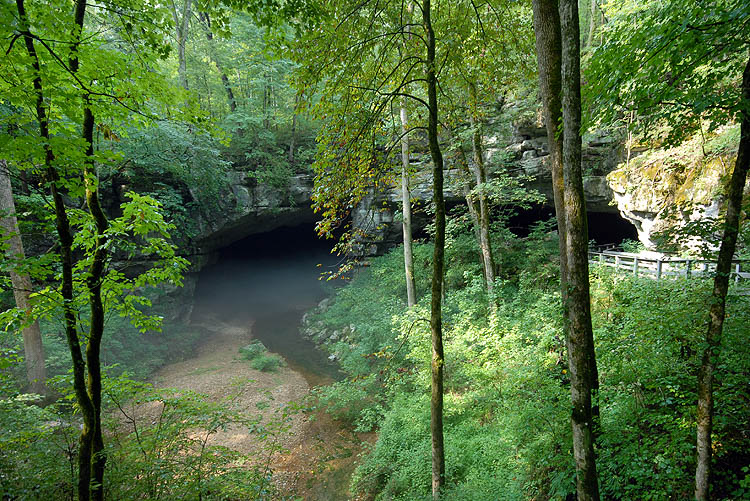
Of all national parks in this list that preserve Native American archaeological sites, Russell Cave National Monument is the only one that mainly preserves ancient sites that are thousands of years old.
Thanks to its unusually large Main Entrance, which faces east, protects against cold north(west)ern winds and is warmed by the morning sun, it became a favored temporary shelter by prehistoric Native Americans.
For many thousands of years, from 6,500 BC to the 17th century AD, it was used primarily as a hunting camp by various different bands. Occasionally, it may also have served as winter quarters or even as a permanent home for a few years.
All these migrating groups left behind traces of their occupation. From spearheads to burial sites, archaeologists have discovered a wealth of prehistoric artifacts in Russell Cave.
In fact, the cave contains one of the Southeast’s most complete records of prehistoric Native American cultures.
Russell Cave National Monument website: https://www.nps.gov/ruca/index.htm

Other Southeast National Parks with Native American Sites
- Poverty Point National Monument, Mississippi – Poverty Point Culture
- Captain John Smith Chesapeake National Historic Trail, Virginia, Maryland, Delaware, D.C, Pennsylvania, and New York – Pamunkey, Mattaponi, Upper Mattaponi, Rappahannock, Nansemond, and Chickahominy
- Trail of Tears National Historic Trail, Tennessee, Georgia, Alabama, Missouri, Arkansas, Oklahoma, and other Southeastern U.S. states – Cherokee, Muscogee (Creek), Seminole, Choctaw, and Chickasaw
20 Recommended Books About Native Americans (Fiction & Non-Fiction)
The Indian Wars
- The Heart of Everything That Is: The Untold Story of Red Cloud, An American Legend – Bob Drury & Tom Clavin
- The Journey of Crazy Horse: A Lakota History – Joseph M. Marshall III
- Bury My Heart at Wounded Knee: An Indian History of the American West – Dee Brown
- The Earth Is Weeping: The Epic Story of the Indian Wars for the American West – Peter Cozzens
- Empire of the Summer Moon: Quanah Parker and the Rise and Fall of the Comanches, the Most Powerful Indian Tribe in American History – S. C. Gwynne
- The Apache Wars: The Hunt for Geronimo, the Apache Kid, and the Captive Boy Who Started the Longest War in American History – Paul Andrew Hutton
- Blood and Thunder: An Epic of the American West – Hampton Sides
- That Dark and Bloody River: Chronicles of the Ohio River Valley – Allan W. Eckert
- Thunder in the Mountains: Chief Joseph, Oliver Otis Howard, and the Nez Perce War – Daniel Sharfstein
General History
- An Indigenous Peoples’ History of the United States – Roxanne Dunbar-Ortiz
- 1491: New Revelations of the Americas Before Columbus – Charles C. Mann
- Streams to the River, River to the Sea: A Novel of Sacagawea – Scott Odell
- The Heartbeat of Wounded Knee: Native America from 1890 to the Present – David Treuer
- Atlas of Indian Nations – Anton Treuer (National Geographic)
Native American Fiction
- Monkey Beach – Eden Robinson
- Ceremony – Leslie Marmon Silko
- There There – Tommy Orange
- The Round House – Louise Erdrich
- An Undisturbed Peace – Mary Glickman
- The Girl Who Sang to the Buffalo: A Child, an Elder, and the Light from an Ancient Sky – Kent Nerburn
Which National Parks With Native American Heritage Sites Have You Visited? Share Your National Parks Experience in the Comments Below!
Disclaimer: The images used in this blog post are in the public domain and courtesy of the U.S. National Park Service.
Other Attractions in National Parks
- National Parks Commemorating African American History
- Greatest Buildings in America’s National Parks
- Top 5 National Parks to See the Northern Lights
- National Parks With Volcanoes
- Best National Parks for Waterfalls
- Best National Parks for Wildflowers
- Amazing Urban National Parks in America
- Best National Parks for Fall Foliage
- 30+ Presidential National Parks






